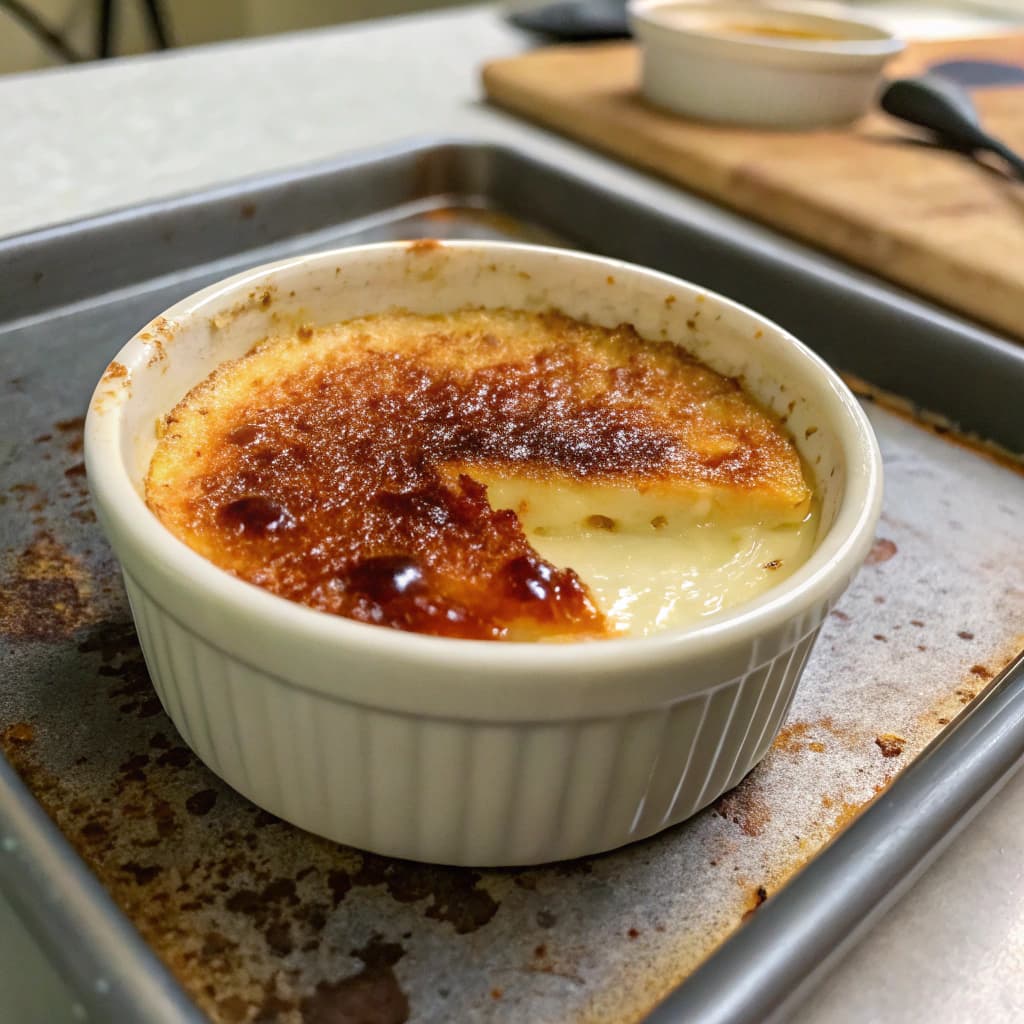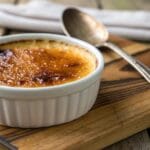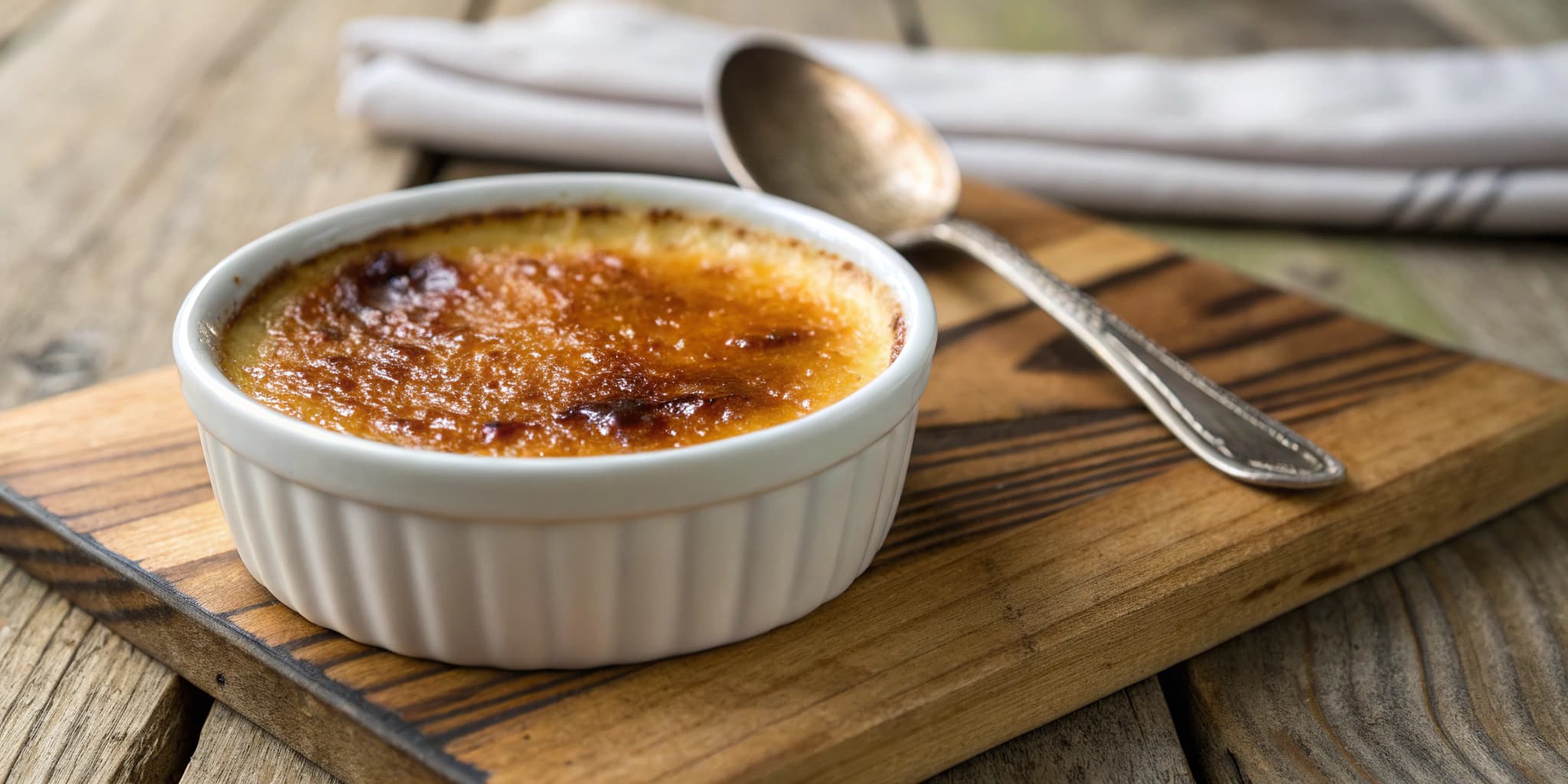Creme brulee curdled? Okay, picture this: You’re feeling fancy, channeling your inner Julia Child, whipping up a beautiful batch of creme brulee. You pour it into those cute little ramekins, gently slide the tray into the oven, and boom—fast-forward to the big reveal and… wait. What the heck? Why does it look like scrambled eggs in a cup?! If your creme brulee curdled , first of all—hey, no shame. We’ve all been there. It’s one of those desserts that looks simple, but honestly? It’s a little dramatic. One wrong move, and it goes from silky smooth to weird and lumpy real quick.
But don’t worry, I’ve got your back. This guide is gonna walk you through exactly why it happens, how to spot it, and—most importantly—how to never let it happen again. You’ll also get some genius ways to save your curdled custard (yep, we’re not tossing that thing just yet), and a full step-by-step method to nail the perfect bake every time.
Oh, and if you’re still trying to master the secret of creme brulee, you have to check out this guide on what makes creme brulee truly magical. Total game-changer.
Let’s crack that sugar crust and get into it.
What Is Creme Brulee, Really?

The Classic Creamy Dream: A Quick Look at the OG Recipe
Creme brulee is one of those desserts that feels fancy without being over-the-top. It’s basically a baked custard made from heavy cream, egg yolks, sugar, and vanilla, finished off with that dreamy burnt sugar topping.
But don’t let its short ingredient list fool you. This dessert is all about precision. A little too hot, a little too fast—and you’re left with something that looks like a breakfast scramble instead of a silky spoonful of heaven.
If you’re curious about how creme brulee stacks up against its cousin, custard, check out this super handy comparison on the difference between creme brulee and custard. Spoiler: It’s all about that caramelized top and the way it’s baked.
Why Texture Matters More Than You Think
Now, let’s talk texture. Creme brulee should be smooth, creamy, and just firm enough to hold its shape. If it turns out gritty, grainy, or separated? That’s curdling, my friend—and it means the eggs cooked too fast or unevenly.
A well-made creme brulee should jiggle ever so slightly when you give the ramekin a nudge. If it jiggles like Jell-O, you’re golden. If it looks like a mini volcano erupted inside? Yeah… we’ve got a problem.
By the way, if you’re tempted to experiment with ingredients—like subbing in milk instead of cream—hold up. That’s a whole different ballgame. Here’s what you need to know about using milk in creme brulee before you go rogue in the kitchen.
Uh-oh… Why Did My Creme Brulee Curdle and How Can You Prevent It?
Okay, so if your creme brulee came out lookin’ more like cottage cheese than custard… it’s probably not your oven straight-up hating you. (Although I’ve had those days too.) More often than not, there’s a good reason behind the curdling—and thankfully, once you know what caused it, you can totally avoid it next time.
Let’s walk through the biggest culprits.
High Heat: The #1 Reason Your Creme Brulee Curdled
This one’s a killer. Creme brulee is super sensitive to heat. If your oven runs hot (and a lot of ovens do, even without you realizing it), it can cause the eggs in the custard to cook too quickly. That sudden heat basically scrambles ’em, separating the protein and water—aka curdling.
Even baking just 10 degrees too hot can mess up the whole thing. So if you cranked the temp thinking, “Oh, this’ll bake faster”—yeah, been there, done that. It’s not worth it.
Tip: Always bake it low and slow, like around 300°F (and honestly, 275°F is even better if your oven runs hot). Use an oven thermometer to double-check. You can snag one for under 10 bucks, and it’ll save you from a whole world of heartbreak.
Rushing Tempering Can Cause Scrambled Creme Brulee
Tempering sounds fancy, but really it’s just the step where you slowly mix your hot cream into the egg yolks without cooking them. Think of it like gently warming them up so they’re ready for the full heat of the oven later.
If you pour the hot cream in too fast? You’ll literally scramble the eggs. You’ll see weird white bits floating in your custard mix before it even hits the oven—and trust me, that’s not the vibe.
My trick: Pour the cream in super slowly while whisking non-stop. Like, don’t stop for anything. Not even a TikTok notification.
You can get the full step-by-step breakdown in this creme brulee failure guide. Seriously, it’s like the kitchen mistakes bible. Bookmark it.
Why Skipping the Water Bath Can Lead to Curdled Custard
Look, I get it. You’re in a rush, and maybe you think the water bath (aka bain-marie) is just some extra fluff. But this is the real MVP for baking creme brulee the right way.
Without it, your custard is baking with dry, uneven heat, and that’s a fast track to Curdle City.
Pro tip: Put your ramekins in a deep pan, pour in hot water until it’s halfway up the sides, and cover it loosely with foil to trap the steam. That keeps everything baking gently and evenly.
No bath = no bueno. You can read more about that (and other booboos) right here.
Overbaked and Grainy: What Causes a Separated Creme Brulee
Let me guess—you left it in a few extra minutes “just to be safe,” right? That’s when the curdling creeps in.
Once the center starts to set too much, the custard overheats and the texture gets weird. It might even crack on top, and we all know that’s not the dreamy brûlée finish we want.
Watch for the jiggle test: You want the edges set but the center still slightly jiggly—like Jell-O after a tap. If it’s stiff all the way through, it’s overdone.
Signs Your Creme Brulee Curdled: How to Know It’s Gone Wrong
So, you pull your creme brulee out of the oven. The top looks okay-ish, but you’re not sure what’s going on underneath. That little voice in your head says, “Is it supposed to look… like that?”
Here’s how to know for sure if things went south.
Jiggle Test vs. Crater Test
The jiggle test is your best friend. While the ramekin’s still warm, gently give it a nudge. If the custard moves like a smooth, wavy blanket—perfect. But if it jiggles in some spots and sits stiff in others? That’s a red flag.
Now, if you’re seeing craters or sunken spots on the surface, that’s a sign of overbaking and overheating. Basically, your custard got too hot and the water and proteins separated, leaving those little sinkholes behind.
The worst is when you spoon into it and it breaks apart like scrambled eggs. If it’s not smooth and creamy all the way through, that means it curdled either in the oven or during tempering.
Texture, Taste, and Visual Signs
Let’s keep it real. You’ll know it curdled the second you take a bite.
A good creme brulee should feel rich and velvety—almost like pudding, but with a more delicate mouthfeel. If your spoon reveals clumps or the texture feels gritty and uneven, that’s curdling.
Taste-wise, it might still be sweet, but the texture ruins the vibe. Sometimes, it even releases a little liquid around the sides, which is a sign the custard has separated.
Also, don’t let the top fool you. You can get a perfect caramelized crust and still have a curdled mess underneath. So always test the texture under that sugar shell.
Can You Still Eat It? Let’s Be Real Here
Alright, so you curdled your creme brulee. Is it ruined forever? Not necessarily.

Safety vs. Taste: Is It Still Good?
The good news? Curdled creme brulee is usually still safe to eat. It’s just not what you hoped for. The eggs are fully cooked, and the sugar’s done its job. But the texture is off, which, let’s be honest, kinda kills the joy.
If it smells eggy or sour, that’s another issue. But if it just looks ugly but smells and tastes fine, you can totally eat it. It’s not gonna hurt you—it just won’t win any dessert awards.
How to Save Curdled Creme Brulee and Still Enjoy Dessert
Here’s where you can get a little creative. If you’re not serving it at a fancy dinner party, you can still turn that curdled custard into something tasty.
- Scrape it into a blender with a bit of extra cream, blend until smooth, then chill it. You’ve got yourself a makeshift mousse.
- Layer it into a parfait glass with fruit and crumbled cookies.
- Use it as a filling for crepes or a topping for pancakes.
- Chill it and call it “custard crumble” and hope nobody asks questions.
We all mess up in the kitchen—what matters is not wasting good ingredients. I’ve turned failed creme brulee into something snack-worthy more times than I can count.
If you’ve ever worked with leftovers, you probably get the vibe. Like when you repurpose rotisserie chicken in new ways—this leftover chicken guide does a great job showing how to save the day when Plan A doesn’t work out. Same energy here.
How to Fix Curdled Creme Brulee Next Time
If you’ve made it this far, you clearly care about getting this dessert right. And honestly, it’s worth the effort. Creme brulee is one of those recipes that makes you feel like a legit home chef when you nail it. So here’s how to keep things from going off the rails the next time you whip up a batch.
Keep That Oven Low and Slow
This one’s at the top for a reason. The best custards bake gently. If your oven’s too hot, you’re just asking for trouble. Even 325°F can be risky in some ovens.
If you’ve got an oven that likes to do its own thing (you know the type), grab an oven thermometer and check how accurate it really is. You want it at 300°F max. Some folks even go down to 275°F for extra control.
Set your ramekins in a preheated water bath, cover loosely with foil, and let them bake low and slow. It’s not the fastest method, but it’s the smoothest. If you want a full look at what not to do, you’ll love this kitchen disaster guide. Been there.
Tempering Like a Pro—No Scrambled Eggs Here
Tempering is where a lot of people trip up. I did, too. More than once.
Here’s how to do it right: After heating your cream, slowly pour it into your egg yolks while whisking constantly. Not a fast pour. Not a trickle while texting. Focus, whisk, and go slow.
This gets your yolks used to the heat without shocking them into curdling. You’ll know you did it right when the whole thing is smooth and warm, not lumpy and weird.
Use a Real Water Bath (Don’t Skip the Foil)
I know, I know—getting hot water into a baking dish while juggling ramekins is a whole thing. But that water bath creates a gentle heat bubble around your custard, keeping it from overheating.
The trick that saved me? Boil the water first in a kettle. Place the ramekins in the pan in the oven and then pour the water in. No spills, no drama.
And don’t forget the foil. Cover the whole tray loosely—don’t crimp it tight—just a casual drape. It keeps the tops from overbaking and holds in steam to protect the custard from cracking or cooking unevenly.
Keep an Eye on the Bake Time (Set That Timer)
If the recipe says 45 minutes, don’t assume yours will take exactly that long. Check it at 35. Give it the jiggle test. If the edges look set and the center still wiggles just a bit, it’s done.
Overbaking is sneaky because it doesn’t always show up until the custard cools. That’s when you realize it got grainy or cracked. A timer is your best defense.
If you’ve ever had issues with other custard-style pies—like cracking sweet potato pies—you’ll see the same rules apply here. Custards are sensitive. They don’t like to be rushed or overcooked.
Kitchen Tools That Help Prevent Curdling
Making creme brulee without curdling it isn’t just about watching the oven like a hawk. It’s also about having the right backup. These tools are the behind-the-scenes heroes that make your custard dreams come true.
Digital Thermometer: The MVP You Didn’t Know You Needed
This right here? Game changer.
You might think your oven is set to 300°F. But ovens lie. They really do. Some run 15–20 degrees hotter without showing it. That’s enough to curdle a custard.
A digital oven thermometer tells you what your oven actually is doing. And if you want to go even more pro, a probe thermometer helps you measure the internal temp of your custard. Pull your ramekins once they hit around 170–175°F in the center, and boom—no curdling.
Don’t have one yet? It’s cheaper than redoing a failed batch.
Ramekins, Sheet Pans & Foil Tricks
Let’s talk setup. If you’re using mismatched ramekins that came from a thrift store haul, I feel you. But different sizes = different bake times = uneven results. Try to stick with ramekins that are all the same shape and thickness.
Set them inside a deep baking pan (like a sheet pan with tall sides or a roasting pan) so you can make that water bath without spills. I always place the whole thing in the oven first, then add hot water. Way less messy.
The foil part? Just loosely tent it over the tray. That protects the tops and keeps things steamy without blocking all the heat. No fancy gadgets needed—just smart layering.
Fine-Mesh Strainer: Custard Insurance
This one’s low-key underrated. After you temper your custard, pour it through a fine-mesh strainer before it hits the ramekins.
Why? Because even if you nailed the tempering, there might still be some rogue egg bits or foam. Straining it gives you that silky-smooth texture without the surprise chunks.
And if you’re someone who’s already felt the heartbreak of weird lumps in your custard, this little step will make a big difference.
It’s kind of like straining your black bean soup—same concept. Ever wonder why your soup tastes bitter? Same deal—sometimes texture and flavor depend on filtering out the stuff you don’t want in there.
A Kettle (Or Microwave-Safe Pitcher)
You need hot water for the bain-marie, right? Don’t struggle with a heavy pot of boiling water. A kettle or even a big microwave-safe measuring cup makes it way easier to pour water around your ramekins without splashing them or burning your hand.
Boil the water separately, place the pan with ramekins in the oven, and carefully pour the water in. No spills, no cracked custards, no panic.
Kitchen Timer or Phone Alerts (Don’t Trust Your Gut)
Don’t bake by feel. I’ve tried that. My gut told me “five more minutes” and I ended up with egg bricks.
Set multiple timers. One for halfway through (just to check the oven isn’t going rogue), one for the minimum bake time, and one as a final heads-up.
It’s just like setting a reminder to pull chicken out of the freezer—one missed step and dinner’s a fail. Speaking of which, if you’ve ever wondered how to freeze cooked chicken properly, that guide is super helpful.
How to Make the Perfect Creme Brulee (Without Curdling It)
This isn’t some vague “just bake it low” type of guide. This is the down-to-earth, real-kitchen process I use after curdling it three times in a row and swearing off desserts for like, a week.
Step-by-Step Recipe with Foolproof Instructions
Ingredients:
- 2 cups heavy cream
- 5 large egg yolks
- 1/2 cup granulated sugar (plus more for topping)
- 1 tsp vanilla extract or one vanilla bean
- Hot water for water bath
Instructions:
- Preheat your oven to 300°F. Double-check with an oven thermometer.
- Heat the cream. In a saucepan over medium heat, bring the cream to just under a simmer — you’ll see tiny bubbles around the edges. If you’re using a vanilla bean, add it now.
- Whisk the yolks and sugar. In a bowl, whisk egg yolks and sugar until it looks pale and a little thicker. Not frothy, just smooth.
- Temper the yolks. Slowly pour the hot cream into the egg mixture, whisking constantly. Do this in a thin stream — no dumping. This part matters.
- Strain the custard. Pour it through a fine-mesh sieve to catch any eggy bits.
- Pour into ramekins. Evenly divide among 4 to 6 ramekins.
- Set up the water bath. Place ramekins in a deep baking dish. Put the dish in the oven, then pour in hot water until it comes halfway up the ramekins.
- Tent loosely with foil. Just a gentle cover, no need to seal it.
- Bake for 35–45 minutes. Start checking at 35 minutes. You’re looking for set edges with a slightly wobbly center.
- Cool and chill. Let ramekins cool, then chill in the fridge at least 2 hours (overnight is better).
- Caramelize the top. Sprinkle sugar on top and use a kitchen torch to melt and brown it. No torch? Use your broiler—just watch it closely.
Done. And if you followed those steps, you’re gonna get that classic, creamy texture—no curdling in sight.
If you want to compare your technique with something a little bolder, check out this crab brulee recipe. It’s a totally different twist, but it follows the same principles.
Tips I Swear By After Ruining My First 3 Batches
- Use a digital thermometer. Know your oven’s real temp and pull the custard once it hits 170–175°F internally.
- Strain every time. I used to skip this and always regretted it.
- Don’t rush the cooling. Creme brulee needs to chill to firm up properly.
- Don’t mess with substitutions. If you’re curious about using milk instead of cream, just know it changes everything—texture, richness, even cook time.
My Creme Brulee Curdling Disaster (and What Finally Worked)
I still remember my first attempt. I baked it at 400°F because I was in a hurry and figured, hey, hotter = faster, right? Nope. What came out looked like sweet scrambled eggs under a sugar shell. I didn’t even chill it. I was too mad.
Next try, I skipped the water bath. Because I didn’t “feel like dealing with it.” Guess what? Curdled again.
The third time, I poured the hot cream into the eggs like I was dumping out a pitcher of lemonade. You can imagine how that ended.
What finally worked? Slowing down. Like, actually reading the recipe, taking my time with the tempering, and treating the whole process like I was babysitting something fragile. Which honestly, I kinda was.
If that sounds familiar, just know you’re not alone. Creme brulee is picky—but once you crack the code, it’s totally worth it.
Print
Creme Brulee Curdled? Here’s What Went Wrong (And How to Fix It!)
- Total Time: 55 minutes
- Yield: 4 servings
Description
Learn why your crème brûlée curdled, how to prevent it, and what you can do to possibly save it.
Ingredients
- Heavy cream
- Egg yolks
- Sugar
- Vanilla extract or vanilla bean
- Hot water (for water bath)
Instructions
- Preheat your oven to 325°F (160°C).
- Gently heat the cream until warm, not boiling.
- In a separate bowl, whisk egg yolks and sugar until combined.
- Slowly temper the cream into the yolk mixture to prevent cooking the eggs.
- Strain the mixture to remove any cooked bits.
- Pour into ramekins and place them in a baking dish.
- Add hot water to the baking dish to create a water bath.
- Bake until just set with a slight jiggle in the center (about 30-40 minutes).
- Cool and refrigerate before adding sugar topping and torching.
Notes
To prevent curdling, avoid overheating the cream, temper eggs slowly, and bake at a low, consistent temperature. If curdled, blend and strain the custard as a salvage attempt.
- Prep Time: 15 minutes
- Cook Time: 40 minutes
- Category: Dessert
- Method: Baking
- Cuisine: French
Nutrition
- Serving Size: 1 ramekin
- Calories: 320
- Sugar: 25g
- Sodium: 50mg
- Fat: 24g
- Saturated Fat: 14g
- Unsaturated Fat: 9g
- Trans Fat: 0g
- Carbohydrates: 26g
- Fiber: 0g
- Protein: 4g
- Cholesterol: 180mg
Conclusion: Creme Brulee Curdled?
So there you have it. Creme brulee might have a fussy side, but once you know the signs, steps, and tools, it becomes totally doable—even fun. Whether you’re impressing guests or just treating yourself, that creamy texture and crisp sugar top is 100% worth it.
And if your next batch curdles again? Take a deep breath, toss it in a parfait glass with some berries, and pretend you meant to do it. That’s called dessert confidence.
FAQs: Answers to Your Creme Brulee Curdled Questions
Why did my crème brûlée go like scrambled eggs?
Because the eggs cooked too fast. That usually happens when the cream is too hot during tempering or the oven temperature was too high. Eggs are sensitive like that—treat ’em gently.
Why does a crème brûlée curdle?
Curdling happens when the proteins in the eggs overcook and separate. This is often from baking it too hot, skipping the water bath, or rushing the tempering step.
What to do if crème brûlée splits?
If it’s already baked and split, you can’t fully undo the texture—but you can blend it smooth and chill it as a mousse or dessert base. It’s not lost, just repurposed.
Why is my crème brûlée separating?
It’s likely that the custard overheated, either during the baking or when mixing in the cream. Once the egg and cream separate, the texture becomes grainy and watery.
Why does crème brûlée scramble?
Usually, the hot cream was added too fast to the egg yolks, or the whole thing was baked without proper heat control. Eggs need to be warmed slowly or they’ll scramble up on you.
How to tell if crème brûlée is undercooked?
Tap the side of the ramekin. If it’s still sloshing in the center and not holding shape, it’s undercooked. You want the edges set and the center just a little jiggly—not runny.
How do you fix curdled custard?
If it’s not fully baked yet and you catch it early, lowering the heat might help. But if it’s done baking, try blending it smooth and using it for another dessert. Total rescue move.

